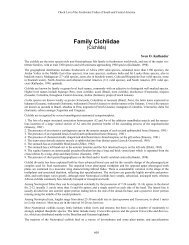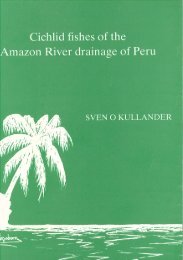Open Access PDF - Sven Kullander
Open Access PDF - Sven Kullander
Open Access PDF - Sven Kullander
Create successful ePaper yourself
Turn your PDF publications into a flip-book with our unique Google optimized e-Paper software.
SL from same sample. It is not obvious to what<br />
extent respectively sexual dimorphism, ontogenetic<br />
change of colour pattern and state of preservation<br />
contribute to variation in expression of<br />
light spots on head and body.<br />
Specimen 298 mm SL, apparently a breeding<br />
female, light greyish with intense contrasting<br />
blackish vertical bars without light margins. Black<br />
spots on head behind eye prominent; two small<br />
black spots on anterior part of caudal peduncle.<br />
Caudal spot ringed with brilliant white spots, not<br />
seen in any other specimen. Spinous dorsal fin<br />
uniformly black.<br />
Largest specimen examined, 430 mm SL, male<br />
with small soft nuchal hump, agreeing largely in<br />
colour with specimens half its size. Ground colour<br />
light brownish, with lighter underside and vertical<br />
bars prominent. White spots on side and head<br />
absent. Fins immaculate save for caudal ocellus.<br />
Live colouration. Photos are available of transplanted<br />
fishes from Brazilian dams, a fresh captured<br />
specimen from the Araguaia (Stawikowski<br />
& Werner, 2004: 38), as well as various sport fishing<br />
magazine photos without locality information<br />
and illustrated here by aquarium specimens<br />
(Fig. 54). General body colour varies from pale<br />
grey (usually) to yellow, with contrasted black<br />
bars. Bars 1a and 2a usually slightly narrower or<br />
paler than bars 1-3. Light ring around caudal<br />
blotch always silvery to white. Very large males<br />
(40-50 cm estimated size) with reddish, prominent<br />
nuchal protuberance, and white spots absent from<br />
fins. Other specimens, estimated size 30-40 cm<br />
SL, possibly females, feature small white spots<br />
on spinous and soft dorsal fins and upper half of<br />
caudal fin as well as on side of head; body side<br />
with or without light spots; anal and pelvic fins<br />
and lower half of caudal fin yellowish to reddish.<br />
Geographical distribution. Natural occurrences<br />
are recorded from the lower (Rio Itacaiunas,<br />
Marabá, Itupiranga), and upper Rio Tocantins<br />
(Rio Paranã), as well as in the Araguaia drainage<br />
(Cocalinho and Rio das Mortes) (Fig. 9).<br />
Cichla piquiti is extensively stocked in reservoirs<br />
in the Paraná river drainage, and the States<br />
of Minas Gerais and São Paulo. Kelber (1999) lists<br />
tucunaré azul from the Itaipu, Porto Primavera,<br />
Jupiá, Três Irmãos, Ilha Solteria, São Simão, Jaguara,<br />
Estreito, Peixoto, Furnas, Avanhandava, and<br />
Promissão dams in the Rio Paraná drainage, the<br />
Ichthyol. Explor. Freshwaters, Vol. 17, No. 4<br />
349<br />
Tres Marias dam in the Rio São Francisco drainage,<br />
and the Serra da Mesa dam in the Rio Tocantins<br />
drainage, as well as from the Rio Piquiri<br />
in the upper Rio Paraguay drainage. The tucunaré<br />
azul corresponds to C. piquiti, according to photographs<br />
provided by D. Kelber. Photos of large<br />
adults were made available by D. Kelber from<br />
Tres Irmãos (Rio Tietê), collected in 1995, and<br />
Itumbiara (Rio Paranaíba). Preserved material is<br />
available from Embarcação and Bocaina, also in<br />
the Rio Paranaíba drainage.<br />
A specimen of C. piquiti from Itiquira on the<br />
Rio Piquirí in the Rio Paraguay drainage was<br />
sampled already in 1980, although Nascimento<br />
et al. (2001) date the first introduction of Cichla<br />
(presumably C. piquiti) into the Piquirí to 1982.<br />
Nascimento et al. (2001) surveyed extensively the<br />
Piquirí and São Lourenço rivers between 1992<br />
and 1995 but found Cichla only in the Rio Piquirí.<br />
Marques & Resende (2005) extended the distribution<br />
to the Pantanal just north from Corumbá.<br />
Cichla piquiti was found together with C. kelberi<br />
in the Rio Limoy (Paraguay) (Figs. 9, 23). Although<br />
there are practically no fish collections available<br />
from the Rio Paraná in the region of the Itaipu<br />
dam before the construction of reservoirs, introduction<br />
seems more likely than natural occurrence.<br />
Etymology. The species epithet piquiti is a Tupi-<br />
Guarani word meaning striped, and is here used<br />
as a noun in apposition.<br />
Local names. Recorded as tucunaré by Costi et<br />
al. (1977) and as tucunaré azul by Kelber (1999).<br />
Notes. Cichla piquiti is known as tucunaré azul<br />
among Brazilian recreational fishermen (Kelber,<br />
1999), with reference to an overall light bluish<br />
impression of living specimens.<br />
Cichla piquiti bears some resemblance to<br />
C. ocellaris and C. nigromaculata in the presence of<br />
five wide vertical bars on the side, but ocellar<br />
markings are absent from the side, and the vertical<br />
bars reach more ventrally on the side. Cichla<br />
piquiti can be distinguished from the sympatric<br />
C. kelberi by the absence of light spots on the anal<br />
fin, presence of bars 1a and 2a, absence of abdominal<br />
blotches, and absence of occipital bar. It<br />
may be confused at small sizes with C. pinima,<br />
which also occurs in the lower Rio Tocantins, but<br />
the two species appear to be only narrowly parapatric<br />
(cf. Figs. 23 and 60).




